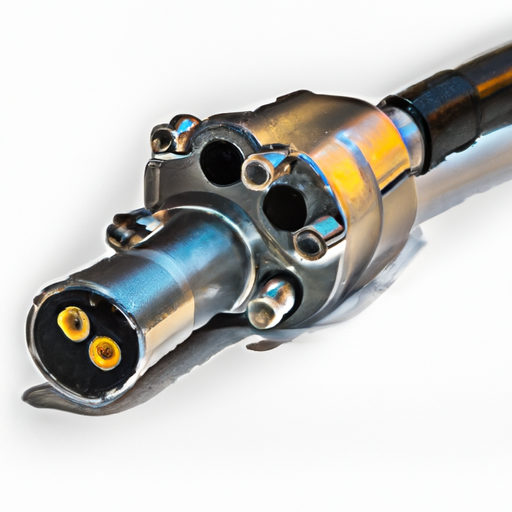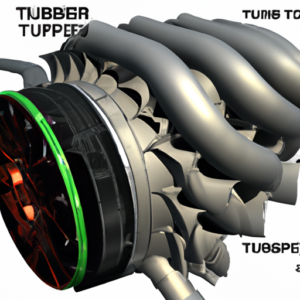
Imagine a world where vehicles can travel longer distances on less fuel, while also reducing harmful emissions into the environment. Common rail fuel injection technology makes this vision a reality. This innovative technology has revolutionized the automotive industry, significantly improving both fuel efficiency and emissions control. By delivering fuel with precision and at high pressures, common rail fuel injection systems optimize combustion, resulting in cleaner and more efficient engines. In this article, we will explore the impact of this technology on fuel efficiency and emissions control, uncovering the benefits it brings to both drivers and the planet.
Overview of Common Rail Fuel Injection Technology
Common Rail Fuel Injection is a state-of-the-art technology that revolutionized the way fuel is delivered to the engine in modern vehicles. It involves the use of a high-pressure fuel rail, which supplies fuel to individual injectors, allowing for more precise control over the fuel delivery process. This technology has evolved over the years and now plays a crucial role in enhancing fuel efficiency and reducing emissions in vehicles.
Definition of Common Rail Fuel Injection
Common Rail Fuel Injection is a fuel delivery system that uses a high-pressure fuel rail connected to multiple injectors. It operates by storing and pressurizing fuel in a common rail, which is separate from the engine cylinders. When the injectors receive an electronic signal, they open and release a precise amount of fuel into the combustion chamber. This method allows for more efficient atomization and distribution of fuel, resulting in improved combustion and reduced emissions.
Evolution of Fuel Injection Systems
Fuel injection technology has come a long way since its early days. In the past, carburetors were used to mix fuel and air before it reached the engine. However, carburetors were inefficient and lacked precise control over fuel delivery. This led to the development of mechanical fuel injection systems, which used mechanical pumps to deliver fuel to the engine. While these systems were an improvement over carburetors, they still had limitations in terms of fuel efficiency and emissions control. The advent of electronic fuel injection systems marked a significant breakthrough, providing better control and precision. Finally, common rail fuel injection systems emerged as the most advanced and efficient method of fuel delivery.
Components of Common Rail System
A common rail fuel injection system consists of several key components that work together to deliver fuel to the engine. These include a high-pressure fuel pump, a common rail, fuel injectors, and an electronic control unit (ECU). The high-pressure fuel pump is responsible for pressurizing the fuel before it enters the common rail. The common rail acts as a reservoir for fuel and maintains a consistent high pressure. The injectors, controlled by the ECU, release precise amounts of fuel into the combustion chamber. This combination of components allows for optimal fuel atomization and distribution, leading to improved efficiency and reduced emissions.
Enhanced Fuel Efficiency
The use of common rail fuel injection technology has a significant impact on fuel efficiency. This is achieved through several key features and mechanisms.
Optimized Fuel Atomization
In a common rail fuel injection system, the high-pressure fuel is atomized into fine particles, allowing for a more thorough and efficient combustion process. This significantly improves fuel efficiency by maximizing the energy extracted from the fuel.
Higher Injection Pressure
Common rail systems operate at significantly higher pressures compared to older fuel injection systems. The higher pressure ensures better atomization and more complete combustion, resulting in improved fuel efficiency.
Precise Injection Timing
One of the key advantages of common rail fuel injection technology is the ability to precisely control the timing of fuel injection. By optimizing the injection timing, the system can ensure that the fuel is injected at the most ideal moment for combustion, leading to enhanced fuel efficiency.
Reduced Emissions
In addition to improving fuel efficiency, common rail fuel injection technology also plays a crucial role in reducing harmful emissions from vehicles. This is achieved through various mechanisms and features.
Improved Combustion Efficiency
The precise control over fuel delivery in common rail systems allows for more complete combustion of the fuel-air mixture. This leads to a reduction in unburned hydrocarbons and improves overall combustion efficiency, resulting in lower emissions.
Lower Particulate Matter
Common rail systems help reduce the formation of particulate matter (PM) in the exhaust gases. The finer fuel atomization and optimized combustion process result in fewer particles being emitted from the vehicle, contributing to cleaner air quality.
Reduced Nitrogen Oxide Emissions
Common rail fuel injection systems can also help reduce nitrogen oxide (NOx) emissions. By allowing for precise control over injection timing, the system can optimize the combustion process, minimizing the formation of NOx gases that contribute to air pollution.
Benefits of Common Rail Fuel Injection Technology
The adoption of common rail fuel injection technology in vehicles offers numerous benefits to both consumers and the environment. Three key areas where this technology proves advantageous are improved mileage and range, reduction in fuel consumption, and lower carbon footprint.
Improved Mileage and Range
Common rail fuel injection systems enable better fuel efficiency compared to older fuel injection systems. This means that vehicles equipped with this technology can travel longer distances on the same amount of fuel, enhancing overall mileage and range.
Reduction in Fuel Consumption
As common rail fuel injection systems optimize fuel atomization and combustion, they reduce fuel waste and improve fuel consumption. This translates into lower fuel costs for vehicle owners and a more sustainable use of finite fuel resources.
Lower Carbon Footprint
The enhanced fuel efficiency and reduced emissions achieved through common rail fuel injection technology directly contribute to a lower carbon footprint. By minimizing the consumption of fossil fuels and decreasing harmful emissions, vehicles equipped with this technology help mitigate the environmental impact of transportation.
Effect on Fuel Economy
Common rail fuel injection technology has a direct and positive impact on fuel economy by improving various aspects of the combustion process.
Enhanced Fuel Combustion
The precise control over fuel delivery in common rail systems ensures that fuel is efficiently burned in the combustion chamber. This results in more energy being released from the fuel, improving fuel economy.
Optimized Air-Fuel Ratio
By accurately controlling the amount of fuel injected into the combustion chamber, common rail fuel injection systems optimize the air-fuel ratio for efficient combustion. This leads to improved fuel economy and reduced fuel waste.
Reduced Unburned Fuel
Common rail fuel injection systems minimize the amount of unburned fuel that is wasted. By ensuring optimal fuel atomization and combustion, these systems leave little to no fuel unused, further enhancing fuel economy.
Impact on Vehicle Performance
Common rail fuel injection technology not only improves fuel efficiency and reduces emissions but also has a significant impact on the overall performance of vehicles.
Increased Power and Torque
The precise control and efficient combustion enabled by common rail fuel injection result in increased power and torque output from the engine. This translates to better acceleration, towing capabilities, and overall performance.
Improved Driveability
Vehicles equipped with common rail fuel injection systems offer improved driveability. The precise control over fuel delivery allows for smoother and more responsive throttle response, enhancing the overall driving experience.
Better Cold Starting
Cold starting a vehicle, particularly in low temperatures, can be a challenge. Common rail fuel injection technology improves cold starting performance by ensuring precise fuel delivery and optimized combustion, enabling easier and quicker engine start-ups.
Technological Advancements in Common Rail Fuel Injection Systems
As technology continues to advance, common rail fuel injection systems have seen significant developments that further enhance their performance and efficiency.
Multiple Injection Strategy
Modern common rail systems use advanced multiple injection strategies to optimize fuel delivery and combustion. By splitting the fuel injection into multiple phases, the system can achieve better fuel atomization and control, resulting in improved efficiency and reduced emissions.
Piezo-Electric Injectors
Piezo-electric injectors are a technological advancement in common rail systems that offer improved precision and control over fuel delivery. These injectors use piezo crystals that respond to electrical signals, allowing for faster and more precise opening and closing of the fuel injectors.
Electronic Control Units
Electronic control units (ECUs) in common rail fuel injection systems have become more advanced over the years. These units continuously monitor various parameters and adjust the fuel delivery accordingly, ensuring optimal performance and efficiency.
Challenges and Limitations
While common rail fuel injection technology offers numerous benefits, it also faces some challenges and limitations that need to be addressed.
High System Cost
The initial cost of implementing common rail fuel injection systems in vehicles can be higher compared to traditional fuel injection systems. This cost includes the components, advanced technologies, and sophisticated manufacturing processes required for common rail systems.
Maintenance Requirements
Common rail fuel injection systems require regular maintenance and servicing to ensure optimal performance. This includes periodic cleaning of injectors, regular inspection of the high-pressure fuel pump, and ensuring the system remains free of contaminants.
Compatibility with Alternative Fuels
Common rail fuel injection systems are primarily designed to work with conventional gasoline and diesel fuels. While some systems can accommodate alternative fuels like biodiesel or bioethanol, compatibility issues may arise, requiring modifications or adaptations to the system.
Comparison with Other Fuel Injection Systems
Common rail fuel injection technology outperforms and offers advantages over other fuel injection systems in various aspects.
Direct Injection Systems
Direct injection systems deliver fuel directly into the combustion chamber, but they often operate at lower pressures compared to common rail systems. This results in decreased fuel efficiency and emissions control compared to the precision and efficiency of common rail systems.
Pump-line-nozzle Systems
Pump-line-nozzle (PLN) systems are a type of mechanical fuel injection system that uses a separate pump to generate fuel pressure. However, PLN systems lack the precise control and flexibility of common rail systems, leading to reduced fuel efficiency and emissions control.
Unit Injector Systems
Unit injector systems, also known as unit pump systems, combine the functions of a high-pressure pump and an injector into a single unit. While these systems offer precise control over fuel delivery, they still face limitations in terms of optimal fuel atomization and distribution.
Future Trends and Developments
As technology continues to evolve, common rail fuel injection systems will continue to see advancements and be adapted to meet emerging needs and challenges in the automotive industry.
Integration with Hybrid Powertrains
Common rail fuel injection technology has the potential for integration with hybrid powertrains. By combining the benefits of hybrid technology with the efficiency and emissions advantages of common rail systems, vehicles can achieve even higher levels of fuel efficiency and emissions reduction.
Adoption in Mass Market Vehicles
While common rail fuel injection technology has been predominantly used in higher-end vehicles, there is a growing trend towards its adoption in mass market vehicles. As manufacturing processes advance and costs decrease, common rail systems are becoming more accessible to a wider range of vehicles.
Potential for Advanced Combustion Modes
With ongoing research and development, common rail fuel injection systems have the potential to enable advanced combustion modes. This includes technologies like homogeneous charge compression ignition (HCCI) and stratified combustion, which can further enhance fuel efficiency and emissions control.
In conclusion, common rail fuel injection technology has had a significant impact on fuel efficiency and emissions control in vehicles. Its precise control over fuel delivery, higher injection pressure, and optimized injection timing have led to improved mileage, reduced fuel consumption, and a lower carbon footprint. This technology has also enhanced combustion efficiency, reduced particulate matter and nitrogen oxide emissions, and improved overall vehicle performance. Despite some challenges and limitations, common rail systems outperform other fuel injection systems and continue to evolve, promising a future of even greater efficiency and environmental sustainability in the automotive industry.







